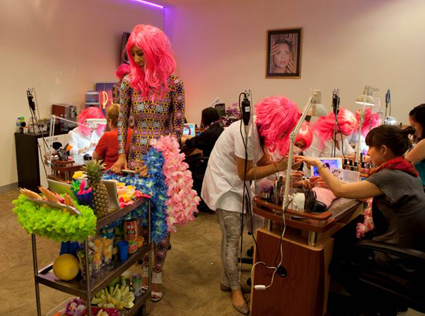Touch me there
Gail Priest, ISEA Artist talks: Siu, Baumann, Velonaki

Thea Baumann, Hologram Holiday part of Metaverse Makeover
photo Russell Shakespeare
Thea Baumann, Hologram Holiday part of Metaverse Makeover
We increasingly entrust machines with our sensual augmentation, constantly allowing them to see and hear for us. However beyond the functional—the moving of objects or handling of hazardous material—we can’t yet entrust them to really touch for us.
Forgive my naïve psychologising but it seems as though both seeing and hearing involve a two-part process, the split allowing space for machine mediation. A machine can record information and show it to us by proxy and then we can see/hear and process it. However with touch it seems as though the recording and the processing are simultaneous and more tightly entwined—our skin actually needs to be in contact in the moment, not presented with a ‘recording’ of the touch. Or is it that perhaps we don’t yet know how to make this touch recording?
Eric Siu
Visiting Hong Kong artist Eric Siu has developed a quite beautiful workaround for this dilemma. In Touchy, , he encourages actual touch between humans but the results are recorded in visual format. Siu has designed a helmet camera with mechanical shutters over his eyes so that when wearing it he is essentially blind. That is until someone touches him (while also placing a hand on a specially wired light bulb). This contact completes a circuit and the shutters spring open revealing Siu’s most beguiling eyes. If you keep touching for 10 seconds, a photo will be taken which can be viewed on the screen at the back of the helmet. Despairing of a world where people are physically shut off, communicating remotely via small screens, Siu is intent on bringing “connection back into reality.” He offers a simple equation: human + social device (ie camera) = happiness. And from his video documentation this appears to be true.
Thea Baumann
Thea Baumann’s Metaverse Makeovers employs a similar equation. She has devised an augmented reality experience for nail bars offering manicures and toxic fume highs. Baumann and collaborators Ben Fern and Shian Law have created nail decorations that are also QR Codes. The human touch of having your nails done can thus be extended into a quasi-magical visual experience, viewed either via personal hand-held devices or on screens in the salon. The fantastical content that appears once the nails have been scanned has been designed in consultation with “nail bar communities.” Baumann has actually attracted investors to this project; Metaverse Makeovers is now a transmedia company concentrating on the Asia-Pacific marketplace to further develop a range of Augmented Reality products for fashion, design and leisure industries. Maybe mediated fingernails are getting us closer to mediated fingertips.
Mari Velonaki
In aesthetic contrast is Mari Velonaki’s Diamandini an ivory-hued interactive robot which responds to the presence of people, approaching or retreating, or hanging around, depending on learned behaviours. Diamandini is being developed over five years as an ARC research project with Velonaki and her team, in particular David Silvera-Tawil, now exploring how touch can be built into her systems utilising specially developed artificial skin emedded with electrodes. Perhaps we are closer to those touch recordings than I thought. (Mari Velonaki also has a work in the Artspace exhibition see realtime tv.)
As I was pondering the theme of this article I came across a Charlie Sofo video work titled Touch, exhibited as part of Experimenta’s Speak to Me. While on a residency in Dunedin, Sofo filmed himself exploring his new environment using his hands—fingertips running over woodgrain, concrete, wire and plants. It’s highly evocative of the memory of touch but it illustrates the kind of tactile muteness to which I allude—the simulation is not yet stimulation. In my fantasies of the future I see a world where Sofo’s artwork will utilise Velonaki and Silvera-Tawil’s artificial skin. I’ll not only be able to see but actually feel that blade of Dunedin grass.






